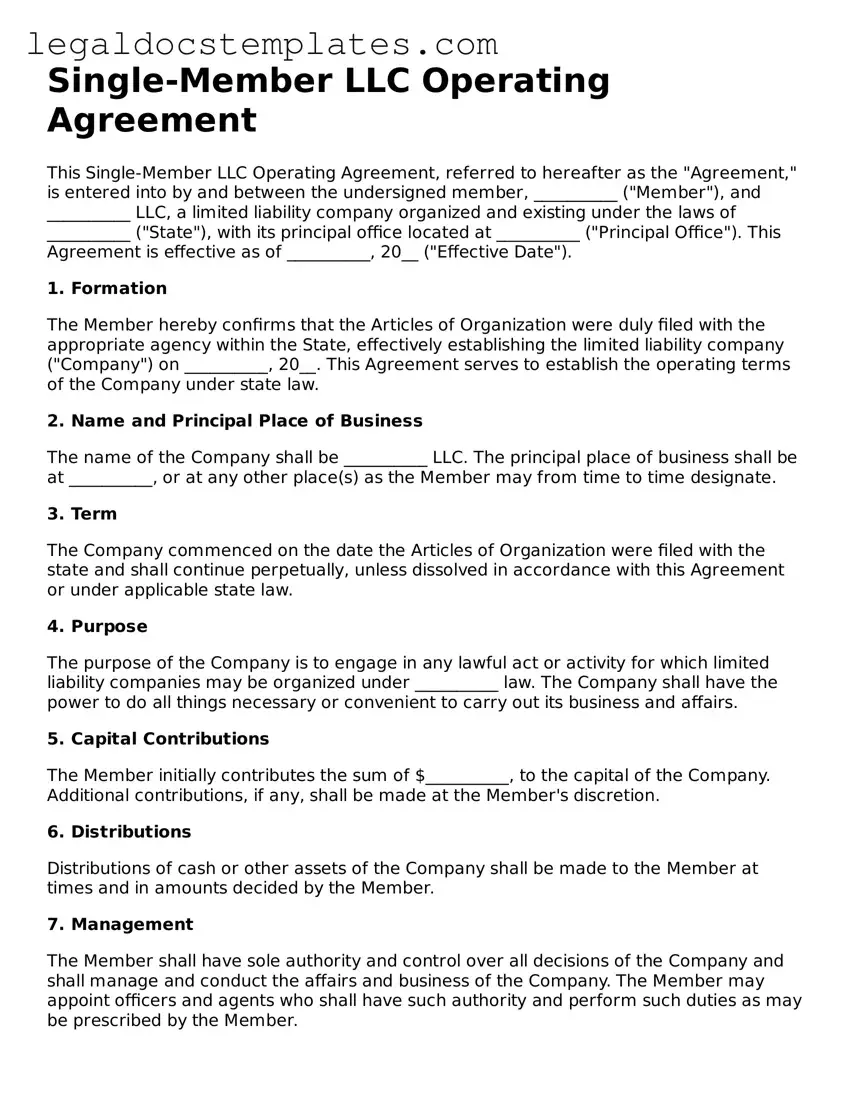Single-Member LLC Operating Agreement
This Single-Member LLC Operating Agreement, referred to hereafter as the "Agreement," is entered into by and between the undersigned member, __________ ("Member"), and __________ LLC, a limited liability company organized and existing under the laws of __________ ("State"), with its principal office located at __________ ("Principal Office"). This Agreement is effective as of __________, 20__ ("Effective Date").
1. Formation
The Member hereby confirms that the Articles of Organization were duly filed with the appropriate agency within the State, effectively establishing the limited liability company ("Company") on __________, 20__. This Agreement serves to establish the operating terms of the Company under state law.
2. Name and Principal Place of Business
The name of the Company shall be __________ LLC. The principal place of business shall be at __________, or at any other place(s) as the Member may from time to time designate.
3. Term
The Company commenced on the date the Articles of Organization were filed with the state and shall continue perpetually, unless dissolved in accordance with this Agreement or under applicable state law.
4. Purpose
The purpose of the Company is to engage in any lawful act or activity for which limited liability companies may be organized under __________ law. The Company shall have the power to do all things necessary or convenient to carry out its business and affairs.
5. Capital Contributions
The Member initially contributes the sum of $__________, to the capital of the Company. Additional contributions, if any, shall be made at the Member's discretion.
6. Distributions
Distributions of cash or other assets of the Company shall be made to the Member at times and in amounts decided by the Member.
7. Management
The Member shall have sole authority and control over all decisions of the Company and shall manage and conduct the affairs and business of the Company. The Member may appoint officers and agents who shall have such authority and perform such duties as may be prescribed by the Member.
8. Liability of Member
The liability of the Member is limited as provided under the laws of the State. The Member shall not be liable for the debts, obligations, or liabilities of the Company, including under a judgment, decree, or order of a court.
9. Indemnification
The Company shall indemnify the Member to the fullest extent permitted by state law against all expenses and liabilities, including legal fees, reasonably incurred in connection with any proceedings involving the Company, where the Member acted in good faith and in a manner reasonably believed to be in, or not opposed to, the best interests of the Company.
10. Dissolution
The Company may be dissolved and its affairs wound up upon the decision of the Member. Upon dissolution, the Company shall distribute its assets according to the laws of the State and pay all its debts and obligations. Any remaining assets shall be distributed to the Member.
11. Governing Law
This Agreement and the rights of the parties hereunder shall be governed by and interpreted in accordance with the laws of the State of __________, without regard to the conflict of law provisions.
12. Amendments
This Agreement may only be amended or modified by a written document duly executed by the Member.
13. Entire Agreement
This Agreement constitutes the entire agreement between the Member and the Company regarding the operation of the Company, and supersedes all prior agreements, understandings, representations, and warranties, both written and oral, between the Member and the Company.
IN WITNESS WHEREOF, the Member has executed this Single-Member LLC Operating Agreement as of the date first above written.
______________________
Member Signature
______________________
Member Name (Print)
Date: __________
